Herschel 400 and Herschel 400 Southern Observing Programs Coordinator:Jack Estes |
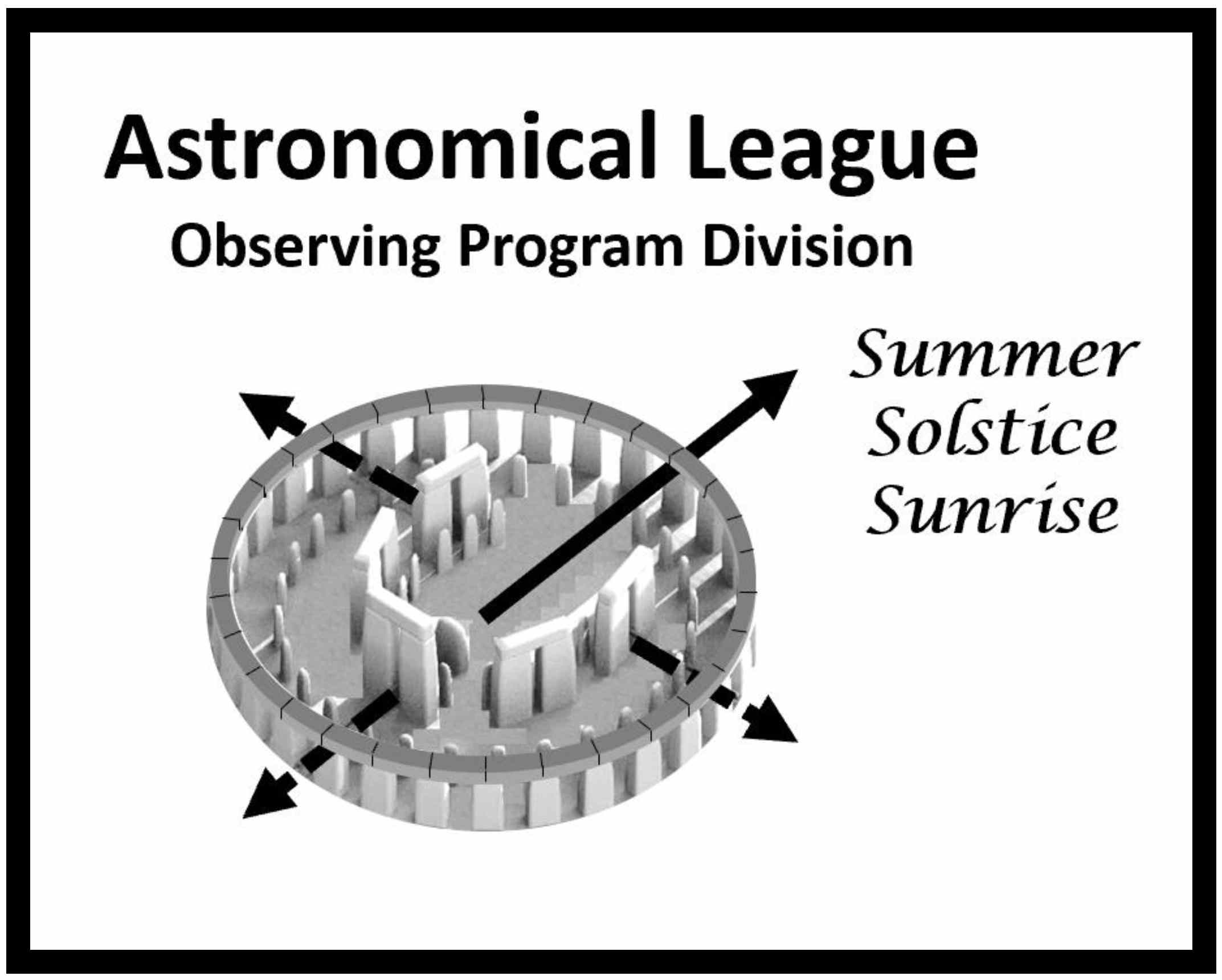 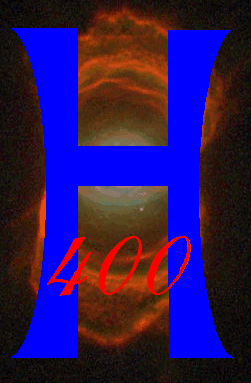 |
IntroductionFor many years, Amateur Astronomers have enjoyed the challenge and excitement provided by the Messier Program of deep-sky objects. The 110 or so objects in the Messier Catalog introduced the observer to the importance of careful observing and record keeping. Upon completion of this project, however, the amateur was left somewhat in a void. He or she wanted to further the quest for deep-sky objects, but outside of the vast New General Catalog, there was no organized program that would provide that next vital step upward. With this idea in mind, the formation of the Herschel Observing Program began. It started when several members of the Ancient City Astronomy Club in St. Augustine, Florida, who had recently completed the Messier Observing Program noticed a letter in Sky and Telescope magazine from James Mullaney of Pittsburgh, Pennsylvania. Mr. Mullaney alerted amateurs to the William Herschel Catalog of deep-sky objects and suggested this would be a good project to get into after completion of the Messier Lists. He went on to say that Herschel’s listings could be found in the original New General Catalog by Johann Dreyer, available from the Royal Astronomical Society in England. The Astronomical League store has a Herschel Observing Manual. It can be purchased here. |
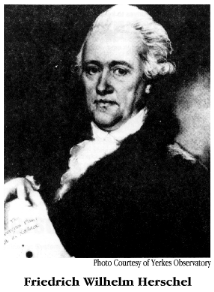 |
Background Information
The New General Catalog was a compilation of several deep-sky catalogs circa 1880; it contained almost 8,000 objects of which 2,477 of these objects were observed by William Herschel. Ancient City Astronomy Club (A. C. A. C.) members began the difficult process of separating Herschel’s objects, which used a rather unique classification system with eight sub-categories; each individual object was placed into a particular subcategory.
These subcategories are:
It was soon discovered that a vast majority of Herschel’s objects were in Class II and III, faint and very faint nebulae, with magnitudes fainter than thirteen, beyond the reach of many amateur telescopes. We of the A.C.A.C. decided that the proposed Herschel Observing Program should consist of enough objects to present a distinct challenge, yet still be within range of amateurs who possessed only modest equipment and were affected by moderate light-pollution problems. After considerable study, we set 400 as the best number of objects to comprise the Herschel Observing Program. Our main references through this process were the Atlas of the Heavens and Atlas of the Heavens Catalog by Antonin Becvar. These two volumes are readily available to the amateur astronomer and contain all the positions, magnitudes, and other pertinent data used in this Observing Program. |
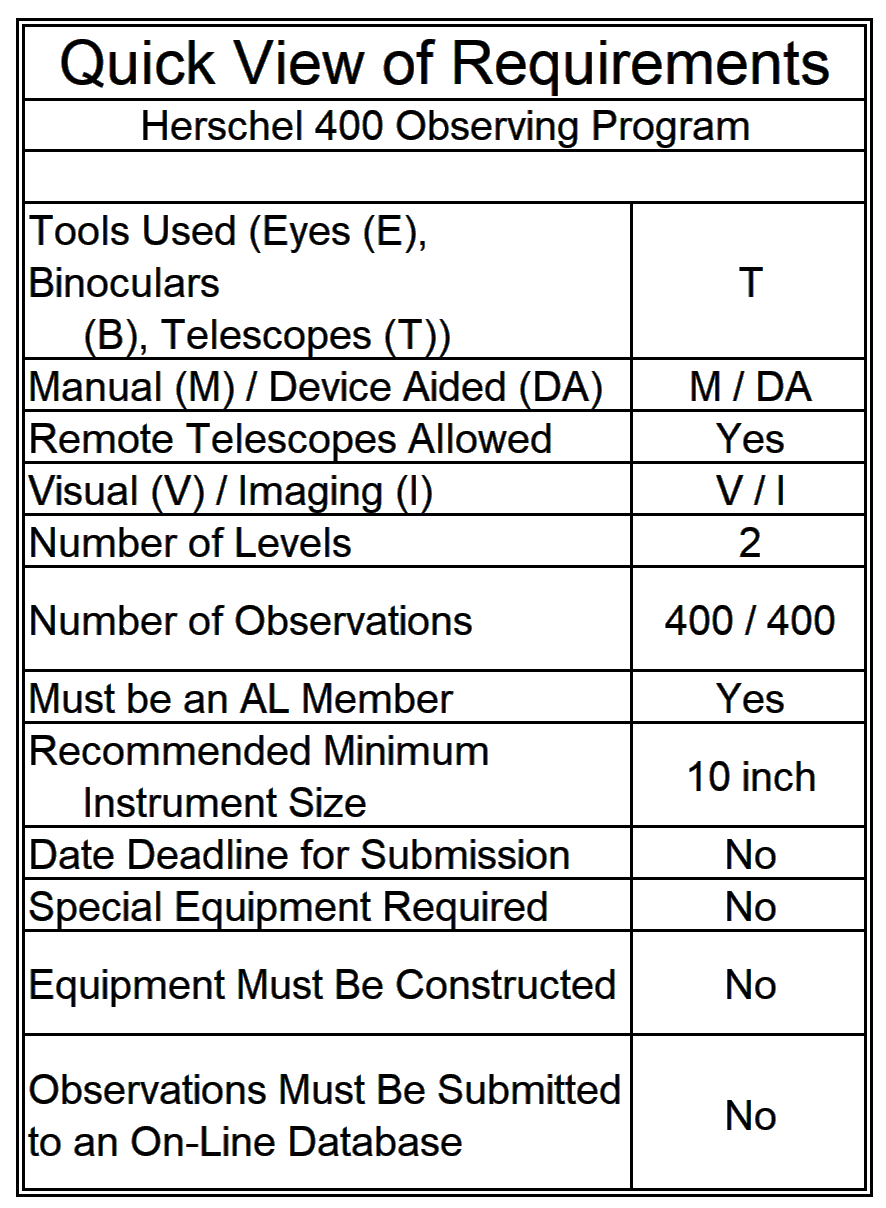 |
| This is meant to be an advanced project for amateurs who already have a fair degree of deep-sky experience. Anyone just starting out should go for the Messier Observing Program first, this will provide the basic groundwork that this project is built on. To those who engage in or complete work on the Herschel 400 Observing Program you can be assured that you will know the sky and the instrument you are using; you will also know your own observing skill. Finally, you will have the curiosity and knowledge that are so important when studying the vast and beautiful universe that we live in.
-Paul Jones |
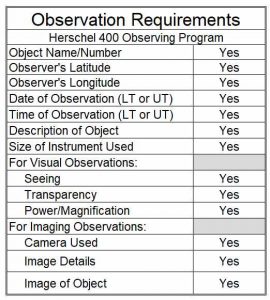 |
Requirements and Rules
This certification is available to members of the Astronomical League, either through their local astronomical society or as members at large. If you are not a member and would like to become one, check with your local astronomical society, search for a local society on the Astronomical League Website, or join as a Member-at-Large
Each observation must include:
- object name
- date and time (either local or UT)
- latitude and longitude
- seeing and transparency
- description of object (for all observations)
- the instrument used and its power
- camera used, image details, and image (for imaging observations)
Special Note:
It has come to our attention that there is an object on the list on the website that is different from an object that appears on the list in the manual. Either object may be used to achieve the Herschel 400 Observing Program certification.
If you are working from the manual, then there is an object NGC 1750 on the list.
If you are working from the list on the website, then there is an object NGC 7814 on the list.
We will be updating the list on the website.
Your collection of 400 observations may contain either one.
The Southern Supplemental Target List
For those members who are in the southern hemisphere, some of the targets on the standard Herschel 400 target list may be too far north to be observed. You may earn the Southern Herschel 400 certification. This certification may be used in place of the Herschel 400 certification for the Master Observer Progression. You may earn both certificates, but a pin will be awarded ONLY when the first certificate is earned.
To earn the Southern Herschel 400 certification, you must observe all 150 objects on the Southern Supplemental Target List as well as at least 250 objects from the original Herschel 400 list (for a total of 400 observations). All other rules are the same for both certifications. (Southern Supplemental List for the Herschel 400, PDF Format, MS Excel Format)
Submitting for Certification
| Once you have completed your observations, you may either send the log to the Herschel 400 Observing Program Coordinator or have them reviewed and evaluated by an officer of your astronomy club. This officer can then email the Observing Program Coordinator.
Be sure to include your name, mailing address, email address, phone number, affiliated society, and to whom the certification should be sent. |
 |
Upon verification of your submission and of your active membership in the Astronomical League, your recognition (certificate, pin, etc.) will be sent to you or to the awards coordinator for your society, as you specified. Your name will also appear in an upcoming issue of the Reflector magazine and in the Astronomical League’s online database. Congratulations. Good luck with your next observing challenge.
Herschel 400 Observing Program Coordinator:Jack Estes |



